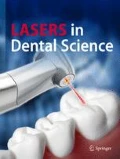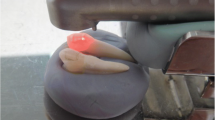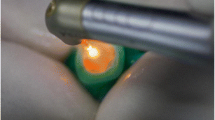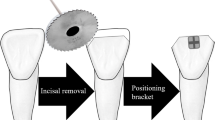Abstract
Aim
The present study aims to evaluate the shear bond strength and the adhesive remnants index (ARI) of metal brackets. For this purpose, enamel etched with acid, Er; Cr: YSGG (2780 nm) laser, and a combination of them.
Methods
In this study, 60 human premolars were divided into three groups (acid, Er, Cr: YSGG (2780 nm) laser, and combined etching). Each group contains 20 teeth. For testing of shear bond strength (SBS), the force applied by a universal testing machine. All the samples were examined under a light stereomicroscope to determine the bond failure mode.
Results
The results revealed that the laser-acid group had the maximum mean shear bond strength while the acid group had the minimum shear bond strength. The values of mean shear bond strength obtained of 25.90, 16.94, and16.60 MPa for laser-acid, laser, and acid, respectively. Laser and acid groups were negligibly different from each other, while they were significantly different from the lasers–acid group (p < 0.05). Regardless of the preparation of the enamel, bond failure occurred predominantly in the enamel-adhesive site.
Conclusions
Er, Cr: YSGG (2780 nm) laser conditioning in combination with acid led to high shear bond strength, but the hazardous effect on tooth should be considered. The bond failure mode was almost similar among all three groups, where there was no adhesive left on the surface of the tooth.


Similar content being viewed by others
References
Habibi M, Nik TH, Hooshmand T (2007) Comparison of debonding characteristics of metal and ceramic orthodontic brackets to enamel: an in-vitro study. Am J Orthod Dentofac Orthop 132(5):675–679
Kitahara-Ceia FMF, Mucha JN, dos Santos PAM (2008) Assessment of enamel damage after removal of ceramic brackets. Am J Orthod Dentofac Orthop 134(4):548–555
Bishara SE, Fonseca JM, Boyer DB (1995) The use of debonding pliers in the removal of ceramic brackets: force levels and enamel cracks. Am J Orthod Dentofac Orthop 108(3):242–248
Botta SB, Da Ana PA, Zezell DM, Powers JM, Matos AB (2009) Adhesion after erbium, chromium: yttrium-scandium-gallium-garnet laser application at three different irradiation conditions. Lasers Med Sci 24(1):67–73
Issar R, Mazumdar D, Ranjan S, Krishna NK, Kole R, Singh P, Lakiang D, Jayam C (2016) Comparative evaluation of the etching pattern of Er, Cr: YSGG & acid etching on extracted human teeth-an ESEM analysis. J Clin Diagn Res 10(5):ZC01–ZC05
Eversole LR, Rizoiu IM (1995) Preliminary investigations on the utility of an erbium, chromium YSGG laser. J Calif Dent Assoc 23(12):41–47
Eversole L, Rizoiu I (1997) Pulpal response to cavity preparation by an erbium, chromium: YSGG laser-powered hydrokinetic system. J Am Dent Assoc 128(8):1099–1106
Lin S, Caputo AA, Eversole LR, Rizoiu I (1999) Topographical characteristics and shear bond strength of tooth surfaces cut with a laser-powered hydrokinetic system. J Prosthet Dent 82(4):451–455
Verma M, Kumari P, Gupta R, Gill S, Gupta A (2015) Comparative evaluation of surface topography of tooth prepared using erbium, chromium: Yttrium, scandium, gallium, garnet laser and bur and its clinical implications. J Indian Prosthodont Soc 15(1):23
Basaran G, Ozer T, Berk N, Hamamcı O (2007) Etching enamel for orthodontics with an erbium, chromium: yttrium-scandium-gallium-garnet laser system. Angle Orthod 77(1):117–124
Basaran G, Hamamcı N, Akkurt A (2011) Shear bond strength of bonding to enamel with different laser irradiation distances. Lasers Med Sci 26(2):149–156
Ghaffari H, Mirhashemi A, Baherimoghadam T, Azmi A, Rasooli R (2017) Effect of Surface Treatment on Enamel Cracks After Orthodontic Bracket Debonding: Er, Cr: YSGG Laser-Etching Versus Acid-Etching. J Dent (Tehran) 14(5):259
Artun J, Bergland S (1984) Clinical trials with crystal growth conditioning as an alternative to acid-etch enamel pretreatment. Am J Orthod 85(4):333–340
Lee BS, Hsieh TT, Lee YL, Lan WH, Hsu YJ, Wen PH, Lin CP (2003) Bond strengths of orthodontic bracket after acid-etched, Er: YAG laser-irradiated and combined treatment on enamel surface. Angle Orthod 73(5):565–570
Reynolds I (1975) A review of direct orthodontic bonding. Br J Orthod 2(3):171–178
Krishnan K, Kumaran NK, Iyer VH, Rajasigamani K (2013) Laser etched vs conventional etched enamel: Effect on shear bond strength of orthodontic brackets. Int J Laser Dent 3:1–6
Chinelatti M, Borsatto M, Pecora J, Palma-Dibb R, Corona S (2006) Effect of Er: YAG laser irradiation distance on superficial dentin morphology. Am J Dent 19(4):217–221
Bishara SE, Gordan VV, VonWald L, Jakobsen JR (1999) Shear bond strength of composite, glass ionomer, and acidic primer adhesive systems. Am J Orthod Dentofac Orthop 115(1):24–28
Suliman SN, Trojan TM, Tantbirojn D, Versluis A (2014) Enamel loss following ceramic bracket debonding: A quantitative analysis in vitro. The Angle Orthodontist. 85(4):651–656
JMd R, Gravina MA, MJdS C, CCA Q, Elias CN, RWF V (2014) Shear bond resistance and enamel surface comparison after the bonding and debonding of ceramic and metallic brackets. Dental Press J Orthod 19(1):77–85
Zachrisson BU, Arthun J (1979) Enamel surface appearance after various debonding techniques. Am J Orthod 75(2):121–137
Day CJ, Price R, Sandy JR, Ireland AJ (2008) Inhalation of aerosols produced during the removal of fixed orthodontic appliances: a comparison of 4 enamel cleanup methods. Am J Orthod Dentofac Orthop 133(1):11–17
Author information
Authors and Affiliations
Corresponding author
Ethics declarations
Conflict of interest
The authors declare that they have no conflict of interest.
Ethical approval
This article does not contain any studies with human participants or animals performed by any of the authors.
Informed consent
Informed consent was obtained from all individual participants included in the study (optional).
Additional information
Publisher’s note
Springer Nature remains neutral with regard to jurisdictional claims in published maps and institutional affiliations.
Rights and permissions
About this article
Cite this article
Roshan, A., Hosseini, N. Effect of acid etching, Er, Cr: YSGG laser conditioning and combining on shear bond strength of orthodontic metal bracket. Laser Dent Sci 3, 235–239 (2019). https://doi.org/10.1007/s41547-019-00080-9
Received:
Accepted:
Published:
Issue Date:
DOI: https://doi.org/10.1007/s41547-019-00080-9




